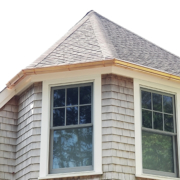 Circumstances vary around gutter systems, so every situation is different. In certain cases, delaying gutter replacement could compromise roofing or the foundation, causing further damage to the property and creating other problems.
Circumstances vary around gutter systems, so every situation is different. In certain cases, delaying gutter replacement could compromise roofing or the foundation, causing further damage to the property and creating other problems.
If you can wait, though, the summer and fall seasons are a great time to tackle gutter replacement. It rains less in summer and fall than in the spring. Even when it does rain in the summer, warmer temperatures dry off rainwater more quickly. This means shorter delays for your project.
The spring season is a great time for assessing the current condition of your gutters. Since showers are frequent during this time of the year, it is likely that your gutter system will take on large quantities of water. This offers a great opportunity for you to test out your gutters to see if they are still capable of draining water efficiently. You can also use this season to plan for gutter installation. Although the job is usually a straightforward process, there should still be sufficient planning before starting the project.
Several factors determine the best time for gutter replacement. Depending on the reason or how urgent the situation, sometimes gutters need to be replaced sooner. The timing depends on your purpose. Below are some factors that will help you decide when you should install new gutters.
New Roof Installation
A great time to install new gutters is when a roof is also being replaced. If your roof has reached the end of its lifespan, you might want to check your gutters as well. It might be time to replace those, too. Having brand new gutters will ensure that they are in the best shape to protect your new roof from water damage.
Selling Your Home
Gutters may not be the most significant factor in curb appeal, but they can certainly make a big difference to the appearance of your home’s exterior. And, sometimes, these minor details can make all the difference to potential homebuyers. So, if you are planning on selling your home soon, you should check your gutters for any noticeable damage like hail marks, cracks or discoloration. Make sure that the sections aren’t pulling away. It’s also important to fix any gutter issues before putting your home on the market.
Mold Problems
The presence of mold in any part of your home can be sign of gutter deterioration. If you have any mold conditions in your home, have your gutter system inspected by a licensed professional. You may have unknown leaks that are allowing water to enter your home. They can assess the condition of your gutters and recommend the best approach.
Rusty Gutters
If your gutter material is metal, you should look for signs of corrosion. Metal gutters typically get rusty as they age, and this can create small pinhole leaks and large holes over time. Depending on the extent of damage, you may only need to replace one section or your entire gutter system.
Preparing for the Wet Season
Your gutter system is critical to keeping rainwater away from your roof. If your gutters have already been showing signs of damage or deterioration, you should have them replaced before the wet season arrives.
Who Should Perform Gutter Installation?
Some homeowners are confident in tackling a DIY gutter installation, but it is usually recommended to leave the job to experienced professionals. This will ensure the best outcome. Remember that your gutters are crucial to protecting your home from water damage. Any mistake during the installation process could compromise its quality and performance. To ensure that your gutter system can really withstand the elements, hire a professional.
Seamless gutters not only reduce the possibility of leaks, but they provide protection against common problems associated with sectional gutters and provide superior protection against future leaks. Here are some of the most common types of damage that can occur due to leaking gutters:
Foundation Issues
Water runoff in unwanted locations, such as the aging seam of a sectional gutter, can cause damage to your foundation over time. In compromised areas, water will wash away soil and expose your foundation, allowing pests, moisture and possibly mold into your home. Once landscaping erodes, the resulting moisture will cause expansion and contraction cycles of the soil around your home. After a period of this repeating cycle, support to the foundation can become compromised, leading to cracked foundations and masonry walls.
Stains on Your Masonry and Siding
Sectional gutters do sometimes fail at the seams over time and with age. If a slow leak develops at the seam of a failing gutter, stains can appear that are difficult to remove.
Another cause of concern is splash back. Rainwater cascading off a roof will impact the ground with enough force to cause splashing, which can contain dirt, grass and minerals that end up on the exterior of your home. Over a short period of time, an unsightly stain may appear.
Damage to Your Landscaping
Plants, flowers, mulch and soil located under the seams of sectional gutters may be impacted negatively from water runoff from rain, sleet and snow. This unwanted collection of water could encourage harmful fungus to develop or attract insects to nest. A properly designed and installed gutter system will keep the soil near your structure at a consistent moisture level by directing roof runoff safely away from the house at designated areas.
More Reasons to Choose Seamless
Maintenance
Seamless gutters are generally known to be largely hassle-free and are lower in maintenance than sectional gutters.
Aesthetic Value
Seamless gutters eliminate unsightly seams. This not only looks great but adds value to your home. Most seamless gutters cost a bit more than sectional gutters, but they lend an upscale, polished look to your home and are worth the investment.
Even with regular maintenance, the elements can degrade your gutters over time. We recommend that you inspect your drainage system for trouble spots at least once a year. And when necessary, take the following preventative measures to protect your drainage system.
Remove Rust
It is important to treat any rust before it does serious damage to your gutter. Remove light rust with a wire brush and be sure to flush or vacuum the resulting debris. You can also use a rust-removing solvent before power-washing your gutters.
Inspect Your Gutters for Leaks
Leaks are generally apparent during rainstorms and snowmelt, but you can also inspect for them by pouring a bucket or two of water into strategic areas of your gutter system. Leaky seams should be sealed with a caulking compound, while small holes can be patched with roofing cement. If a segment of gutter is especially leaky, it may warrant replacing.
Reline Your Gutter
After fixing leaks and removing rust, you should consider relining your gutter with a rubber sealant. A quality rubber sealant can protect gutters from rust, maintain seam integrity and facilitate better drainage.
Install Gutter Screens
If your building is located in an area with lots of trees or other sources of debris, you may choose to install gutter screens. These devices range from simple metal grates to nylon screens to foam filters.
Trim Surrounding Trees
At least once a year, you should trim any overhanging tree branches to reduce the number of leaves ending up in your gutter in the fall.
Clean Your Roof
Keeping your roof clean is a good idea for a variety of reasons. One of them is that the more debris that’s on your roof, the more that will find its way into your gutters.
Check Gutter Pitch
Test your gutter pitch by pouring a bucket of water into your gutters, to ensure that they remain properly sloped and water is draining.
Assess Damage
If you gutter health has declined to a severe extent, it’s probably time to call a professional to ensure damage is repaired properly.
It can be easy to overlook just how much gutters do to protect your building. Channeling water away might seem like a simple and routine function, but your gutter system provides proper drainage for rain and snow and protects your roof, walls and foundation from water damage.
When gutters are working properly, we hardly notice them at all, but when they become rusted, leaky, or blocked, they can be a major headache. This is why it is important to perform routine cleaning and maintenance of your gutters and downspouts, and even restore them if necessary.
You may not realize it, but cleaning your gutters is important to the overall health of your home. If left neglected, serious water-related issues can occur, such as:
Foundation damage
Structural issues
Fascia and soffit rot
Mold and mildew
Basement flooding
Decorative trim damage
Roof damage
Seasonal Threats to Gutters
Your gutters face a variety of hazards all year round. Here are some seasonal pitfalls to guard against.
Spring
Heavy, wet spring snows can weaken joints and seams, and fluctuating temperatures can cause freeze-thaw cycles that widen seams and gaps. Accumulated dirt and debris from fall and winter can cause blockages.
Summer
Persistent or heavy rainfall can leak through compromised seams. Water exposure can lead to rust.
Fall
Leaves and other debris can clog gutters and result in blockages, which can lead to rust and water accumulation on the roof.
Winter
Freezing temperatures can lead to ice accumulation, which can compromise seams. Freeze-thaw cycles can exacerbate damage from built-up ice. Persistent freezing temperatures can lead to ice dams, causing blockage.
Maintaining Your Gutters
Here are some ways to head off gutter damage.
Clean Regularly
The most important thing you can do to protect your gutters and downspouts is to clean them regularly to avoid blockage and moisture accumulation. For most drainage systems, this is as simple as removing gutter debris using your hands or a trowel, and flushing downspout blockages. Other systems may require more thorough cleaning methods.
Self-Clean or Hire A Pro?
When it comes time to clean gutters, many people elect to do it themselves, while others pay to have it done professionally.
While most people can adequately clean their own gutters, a professional service will use specialized equipment that cleans more effectively and typically go through a routine checklist of tasks for a meticulous clean.
Safety is another concern. Professional gutter cleaning crews have developed the dexterity required to perform this kind of work at a height and they climb ladders daily.
Hiring a professional will be quicker and more thorough. Additionally, for buildings that are especially large or tall, a professional service may be the safest way to go.
Our gutters work hard to maintain healthy drainage around our property, but they’re constantly exposed to small hazards that can wear them down over time. It’s crucial to keep drainage systems in good condition with regular maintenance and cleaning, and by addressing small damages before they become huge problems.

The Highest Quality Gutter Protection for Your Home
Call Today: 860-876-2227
Providing gutter installation and maintenance services to New Haven, Middlesex, and New London Counties
© Copyright 2024 The Gutter Specialist, All Rights reserved | Licensed #HIC 0643225 | Fully Insured





